New England Ice Dam Guide -Signs and Solutions
Ice dams are a homeowner’s worst winter nightmare, turning the charm of snowy rooftops into costly chaos. These icy barriers form at the roof’s edge, trapping water and leading to problems like leaks, structural damage, and even mold.
Table of Contents
Without proper insulation and ventilation from quality roofing, heat escapes from your home, melting snow on the roof. The water refreezes at the colder edges, creating a dam that blocks additional runoff and forces water into your home.
From lifting shingles to dripping into walls and ceilings, ice dams can wreak havoc on your home’s structure. They may even create damp conditions that attract termites, adding to the list of costly repairs. Whether you’re facing roof leaks or water damage from ice dams, you’ll need to learn their root causes and address them before they cause major damage.
While ice dams might seem inevitable in climates like New England, the good news is that ice dams are preventable! By understanding how they form, spotting early warning signs, and implementing proactive measures, you can keep your roof safe and your home protected through every New England winter.
Let’s talk about New England’s insidious ice dams, the damage they can inflict, and the steps you can take to prevent and repair them effectively with the help of Coastal Windows & Exteriors.
New England 2024-2025 Winter Predictions & What It Means for Ice Dam Formation
Are you wondering what the winter holds for New England this season? According to the Farmers’ Almanac 2024, homeowners should prepare for a Wet Winter Whirlwind. With heavy snow, rain, and sleet in the forecast, conditions are ripe for ice dam formation, leading to potential damage like roof leaks, moisture issues, and wood rot. Let’s break down what these predictions mean for your home.
Farmers’ Almanac 2024: A Stormy Forecast
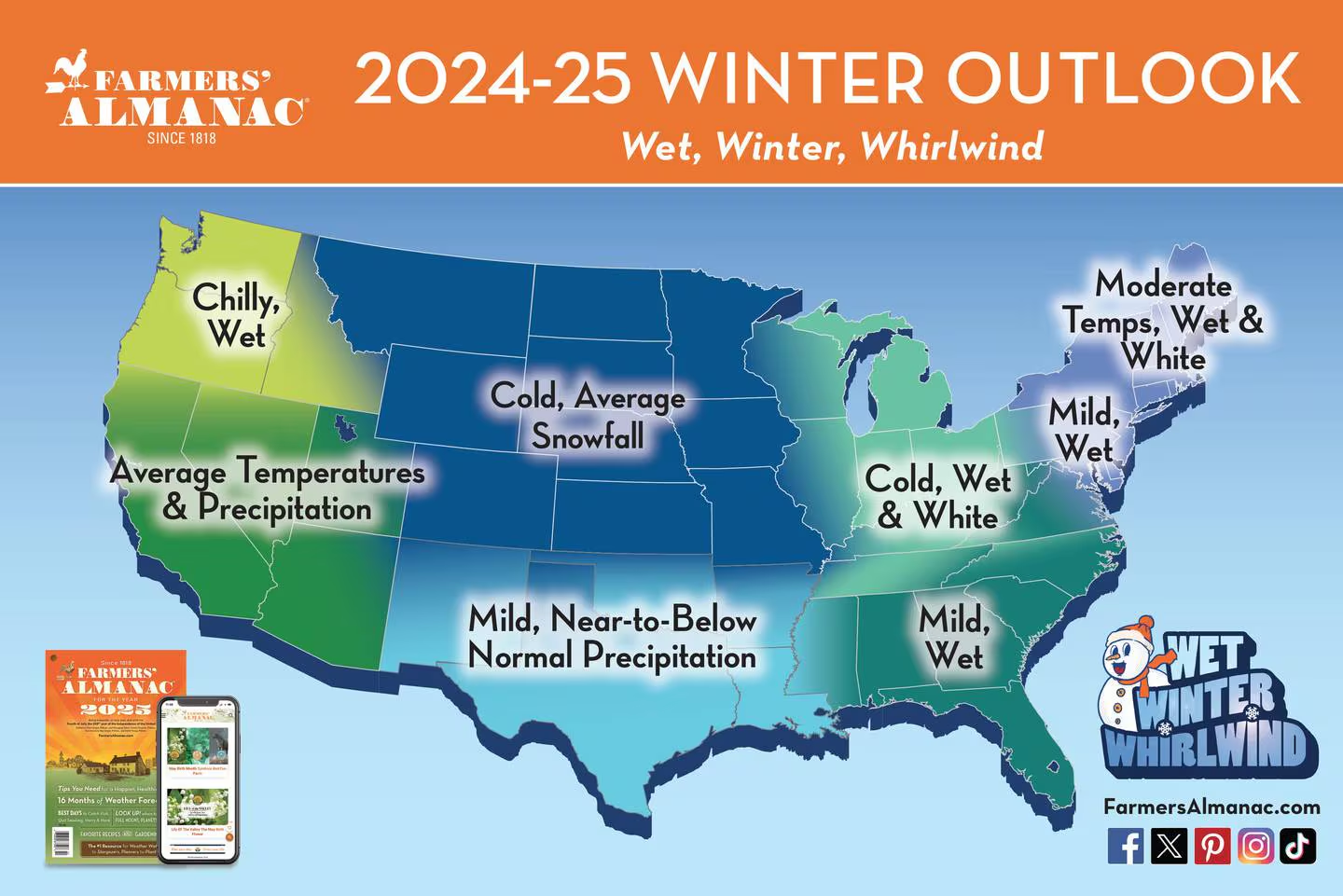
The Farmers’ Almanac 2024 winter prediction paints a stormy picture for New England. For those along the I-95 corridor, the outlook includes higher levels of sleet and rain. Coastal homes, in particular, will face the burden of heavy, wet snow, which is four times denser than light snow. This added weight can stress your roof and increase the likelihood of roof leaks and ice dam damage.
The region is expected to face rapid-fire storms delivering a mix of rain and snow with above-normal precipitation and near-to-above-normal temperatures. This combination creates the perfect environment for ice dams on roofs to form. This is especially true with the frequent freeze-thaw cycles characteristic of these conditions.
The Oreo Cookie Freeze-Thaw Cycle
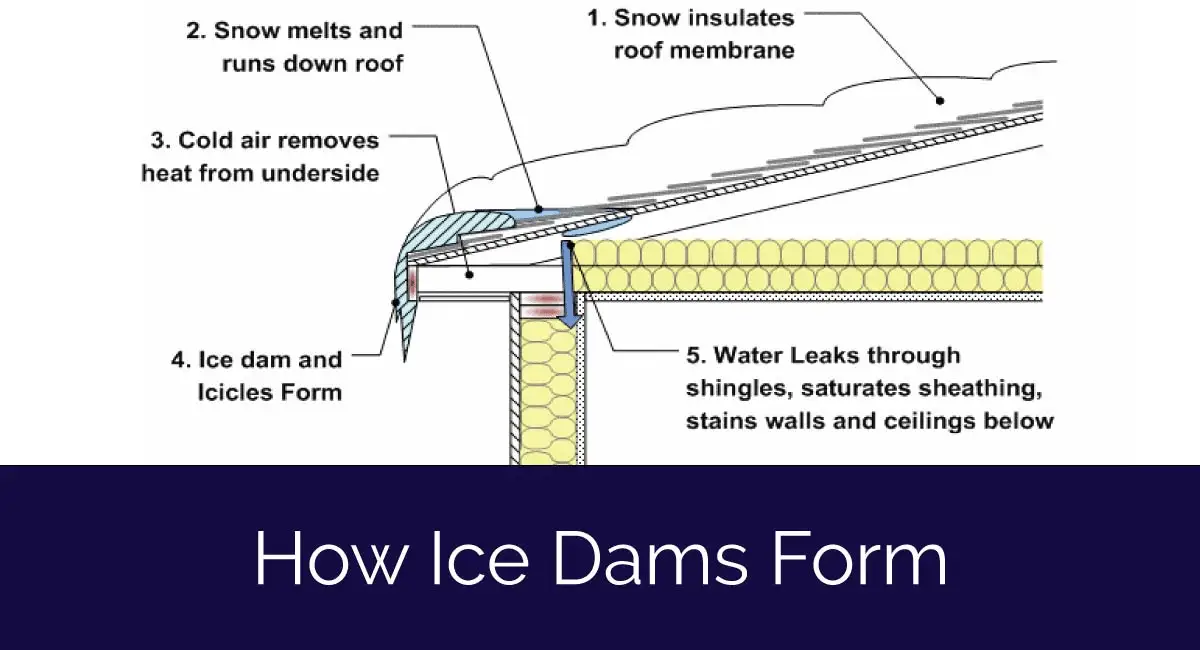
Ice dams often form through a process we like to call the “Oreo cookie freeze-thaw cycle.” This cycle begins when snow melts during warmer daytime temperatures or from heat escaping your attic. As the water flows down your roof, it reaches the colder eaves and refreezes, forming a layer of ice.
Here’s how it works:
- Melting Layer: Snow acts like the cream filling of an Oreo, with the top layer melting due to attic heat or the sun’s warmth.
- Refreezing at the Edges: The water flows down to the roof’s edge, where it freezes into a solid ice layer—the bottom cookie in this analogy.
- Cycle Repeats: As snow continues to melt and refreeze, the layers of ice grow, blocking water runoff and trapping it on your roof.
This repetitive cycle builds an ice dam over time, creating more pressure on shingles and gutters. The trapped water eventually finds its way under shingles. This is ultimately what leads to roof leaks and potentially severe interior damage.
Historical Impact of La Niña
La Niña events have historically influenced weather patterns, leading to notable variations in snowfall and temperature. For instance, during La Niña winters from 1959 to 2024, regions regions like the Great Lakes and Northeast experienced above-average snowfall.
New England La Niña Predictions for Winter 2024-2025
This year, La Niña could significantly influence New England’s winter weather. According to NOAA, there is a 60% chance of La Niña developing. There is also an equal likelihood of above- or below-normal precipitation in Massachusetts and the region. This variability, combined with atmospheric patterns like the polar vortex, makes snowfall predictions uncertain.
These fluctuations make it difficult for snow to remain fluffy and manageable. Instead, rapid warming periods followed by freezing temperatures will encourage ice dams to form at an accelerated rate.
Why This Winter’s Predictions Matter for Ice Dams
New England’s mix of wet snow, sleet, and rain makes ice dams a nearly inevitable challenge for many homeowners. Here’s why these conditions increase ice dam risks:
- Frequent melting and refreezing: Warmer days and colder nights cause snow to melt and refreeze at roof edges, creating solid ice dams. We call this the Oreo cookie freeze and thaw cycle!
- Heavier precipitation: Above-normal snowfall and sleet add extra weight to roofs, putting pressure on shingles and gutters.
- Wet snow accumulation: Denser snow increases the risk of blocked gutters, which can exacerbate rain gutter ice dams and lead to water infiltration.
Can Ice Dams Cause Roof Damage?
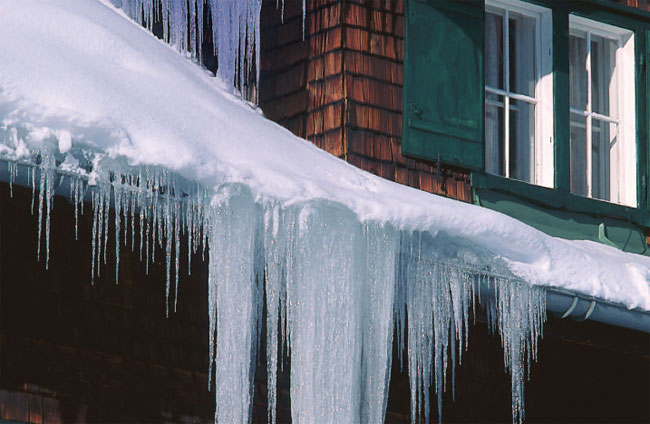
Ice dams may seem like a seasonal nuisance, but they can cause widespread damage to your New England home’s roof, walls, and interior. These frozen barriers compromise the integrity of your roofing system and create conditions ripe for water leaks or structural decay.
Here’s a detailed look at how ice dams can wreak havoc and why addressing them promptly can save you from costly roof leak repair.
Heavy Weight and Roof Damage
Ice dams can grow incredibly large and put a tremendous amount of weight on your roof. In fact, if the ice dam is making your roof leak, you can bank on the ice dam weighing a few thousand pounds.
This immense pressure can lift shingles, exposing areas beneath them to water. When the frozen ice that’s lifted your shingles melts once again, water will seep through your roof and into your home unless you have Roof Deck Protection and Leak Barrier installed beneath your shingles.
The damage caused by heavy ice dams includes:
- Shingle lifting: Ice expands as it freezes, dislodging shingles.
- Exposed roof decking: Once shingles are lifted, water can seep into the roof structure.
- Weakened roof integrity: Prolonged exposure to ice and water can lead to rotting wood.
Interior Leaks and Water Stains

Leaks can travel into walls and ceilings, causing water stains, damage to insulation, and even electrical hazards from water near light fixtures. As ice dams block proper drainage, meltwater pools find a path into your home. This results in visible issues like:
- Water stains on ceilings and walls.
- Dripping or pooling water near windows and fixtures.
- Damp insulation that reduces energy efficiency and promotes decay.
Unchecked, these leaks can lead to the need for extensive roof leak repair, drywall replacement, and insulation upgrades.
Mold and Structural Problems
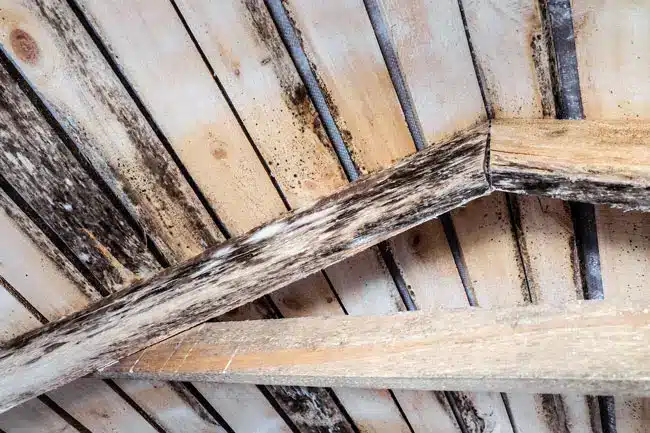
The damage from ice dams doesn’t stop at visible leaks. Even the hidden areas of your home aren’t safe. Ice dams can cause water to drip down into soffits or travel inside walls, resulting in significant structural damage. This moisture creates an ideal environment for mold, which can:
- Spread quickly behind walls and ceilings.
- Pose serious health risks, especially for those with allergies or respiratory issues.
- Lead to costly mold remediation services.
In addition to mold, prolonged exposure to moisture can weaken structural beams, creating a safety hazard. This can escalate repair costs significantly.
How Ice Dams Can Attract Termites
Did you know that ice dams can create an inviting environment for termites? Termites thrive in damp conditions, and the moisture from ice dams often provides the perfect breeding ground. When water seeps into your walls, ceilings, or insulation due to ice dams, it creates the kind of moisture termites need to flourish.
Here’s how the connection works:
- Moisture Accumulation: Ice dams cause water to back up under shingles and into your home, soaking wooden structures like beams and rafters. This prolonged dampness softens the wood, making it easier for termites to chew through and build their colonies.
- Hidden Entry Points: As water damage weakens your home’s structural integrity, it creates cracks and gaps in walls or ceilings. These hidden entry points give termites easy access to invade without immediate detection.
- Unchecked Infestations: Because termites are often unnoticed until significant structural damage occurs, the moisture from ice dams gives them a head start at causing extensive damage. Worst of all, you might not even aware of their presence.
How to Prevent Termite Infestations Linked to Ice Dams
- Install at least 6 feet of Ice & Water Shield beneath your shingles to prevent water infiltration in high-risk areas like eaves and valleys.
- Address roof leaks immediately to stop water from soaking into your home’s wood structures.
- Keep your attic dry by improving ventilation and sealing air leaks, reducing the conditions that termites love.
Costly Roof and Home Repairs
When ice dams form, the damage isn’t isolated to the roof. Leaks can travel into walls and ceilings, causing water stains, damage to insulation, and even electrical hazards. Homeowners dealing with ice dam-related problems may face:
- Roof replacement due to compromised shingles and decking.
- Repairs to drywall, ceilings, and flooring damaged by leaks.
- Electrical fixes to address water-damaged wiring or fixtures.
Addressing roof leaks and ice dam issues early can prevent these costly repairs from snowballing into an even bigger financial burden.
Warning Signs for Ice Dams
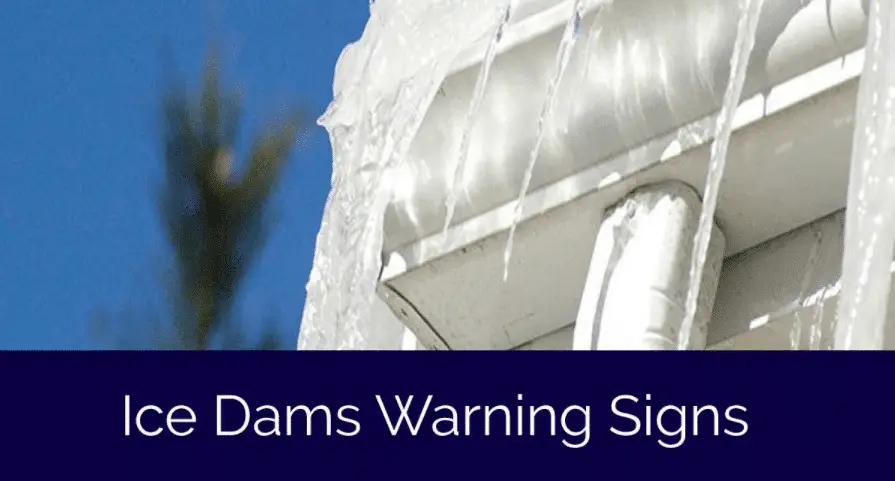
Ice dams don’t form overnight—they often develop gradually, showing subtle signs before causing significant damage. Catching ice dam formation early can help you protect your home and avoid the need for roof leak repair. Below are the key indicators that ice dams may already be forming or that your home is at risk.
Early Warning Signs that Ice Dams May Form
It’s time to think about prevention in this phase of ice dam warning signs. Before the snow even falls, your home might already hint at vulnerabilities. Mold, moisture, and irregularities in your attic are major clues. Watch for the following:
- The temperature inside your attic is not the same as the temperature outside.
- Condensation on items and/or signs of water where it shouldn’t be.
- Drafts around your chimney, recessed lighting receptacles, or bathroom fans.
- Unreasonably high energy bills caused by heat escaping into the attic.
If your roof is flat or slightly pitched, also look for signs like bent, bowed, or cracked rafters. These structural irregularities could signal that your roof won’t handle heavy snow and ice, which may lead to ice dams on roofs.
Red Flag Warning Signs – Take Action Now!
Once winter arrives, the signs of ice dam formation become more obvious. Large icicles hanging off the side of your home or thick snow glares at least 5” thick are clear indications. Here’s what else to look for:
- Leaking windows that appear to have condensation or water dripping inside.
- Water stains on your ceilings or walls, especially near light fixtures.
- Ice buildup in your gutters or at the roof’s edge, leading to blocked drainage.
These issues can quickly escalate if left unresolved, leading to roof leaks and damage to insulation, drywall, or even electrical wiring. Unchecked moisture can seep into your walls, floors, and ceilings, creating the perfect environment for mold. Over time, structural beams and roof decking may rot, requiring costly replacements.
At Coastal Windows & Exteriors, we want you to have a safe winter season, free from ice dams! In the next section, we’ll explore proven methods to prevent ice dams from forming, saving you the stress and expense of dealing with their aftermath. Stay ahead of winter damage by acting on these early warnings!
How to Get Rid of Ice Dams: Proven Methods that Work in New England
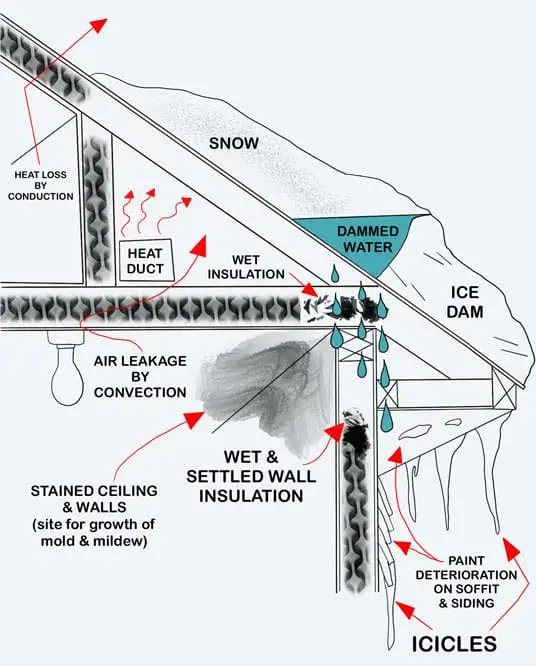
Preventing ice dams requires a proactive approach to addressing the root causes of their formation With proper insulation, improving ventilation, and following best practices for roof maintenance, you can protect your home from the damage these icy culprits cause. Here’s a detailed look at the strategies you can implement to keep ice dams on roofs at bay.
Insulation Matters for Ice Dam Prevention
One of the main causes of a warm attic—and therefore ice dams—is inadequate insulation. Without proper insulation, heat escapes into your attic, warming the roof and melting snow that refreezes at the edges. To prevent this, ensure your attic meets recommended R-values for insulation (at least R-38 or higher in colder climates).
Seal air leakage areas around recessed lighting cans, electrical cables, and vent pipes. Gaps in these areas allow warm air to escape, heating the attic and creating ideal conditions for ice dam formation. Use caulk or foam to close these gaps and maintain consistent attic temperatures.
Prevent Ice Dams with Airflow in Your Attic
Ventilation in your attic space is essential to maintaining the correct temperature. An attic should mirror outdoor temperatures to prevent snow from melting and refreezing on your roof. Without effective ventilation, warm air becomes trapped, melting the snow on your roof. It then refreezes at the colder edges, forming ice dams.
The key to proper ventilation lies in the balance of intake and outtake vents:
- Ridge Vents: Installed along the peak of your roof, ridge vents act as outtake vents that expel warm air from the attic. This constant airflow prevents heat buildup, ensuring your roof stays cool even when your home is warm. GAF Cobra® Ridge Vents are an excellent choice for reliable, high-performance outtake ventilation.
- Soffit Vents: Located under the eaves of your roof, soffit vents function as intake vents. They draw in cold air, which pushes warm air upward and out through the ridge vents. Pair these with GAF Intake Vent Products, such as Cobra® IntakePro™, to maintain the perfect airflow balance.
When ridge and soffit vents work together, they create a continuous flow of air that keeps your attic and roof temperatures consistent. However, ventilation isn’t as simple as installing vents—it needs to be properly calculated and implemented:
- You should have 1 square foot of ventilation for every 300 square feet of attic floor space.
- Intake vents (soffits) and outtake vents (ridges) must be balanced to ensure smooth airflow. Too much of one can disrupt the system and reduce effectiveness.
In addition to using top-quality products like GAF Cobra® Ridge Vents and GAF IntakePro™, it’s crucial to check for obstructions. Blocked soffit vents—caused by insulation or debris—can prevent cold air from entering the attic. Periodically inspect and clear vents to maintain their function.
How to Prevent Ice Dams and Gutters: Gutter and Roof Maintenance Matters
Regular roof maintenance is another critical step in preventing ice dams. Clean your gutters and downspouts before winter to ensure proper drainage of melting snow and rain. Blocked gutters can trap water, leading to rain gutter ice dams that worsen ice buildup at the roof’s edge.
In areas prone to heavy snow, use a roof rake to safely remove snow from the roof’s edge. This eliminates the insulating layer of snow that contributes to melting and refreezing.
Will Heated Gutters Stop Ice Dams?
Heat cables and gutter heaters to prevent ice dams can help reduce the chances of ice forming in critical areas. When warming gutters and eaves, these systems can keep water flowing even in freezing temperatures. However, they should be viewed as a supplement and not a replacement for proper insulation and ventilation. Without addressing attic heat loss, these tools won’t stop ice dams entirely. If you are at a crossroads of choosing gutter heaters or a new roof, a new roof will provide you with substantially more protection!
Best Roofing Features for Ice Dam Prevention for New England Homes
Your roof is the first line of defense against ice dams. Equipping it with the right features can make all the difference! From high-quality underlayment to specialized leak barriers, these components work together to protect your home from winter’s icy grip. As a New England homeowners, these are the must-have roofing features that will safeguard your roof and prevent ice dams on roofs.
Ice & Water Shield: The Best Barrier Against Ice Dams
Ice dams form when water from melted snow refreezes at the roof’s edge, creating a barrier that traps additional water. Without proper protection, this water seeps under shingles and into your home. Installing a premium ice and water shield is essential to prevent leaks in vulnerable areas like valleys, eaves, and rakes.
- GAF WeatherWatch® Ice & Water Shield is a top-tier product that provides durable, watertight protection for your roof. We install this product up to 6 feet for ultimate protection.
- It’s particularly effective in areas prone to roof leaks, such as chimneys, skylights, and vents.
- For extra protection, we extend the shield 6 feet up from the eaves to block water infiltration during freeze-thaw cycles.
Roof Deck Protection for Added Durability
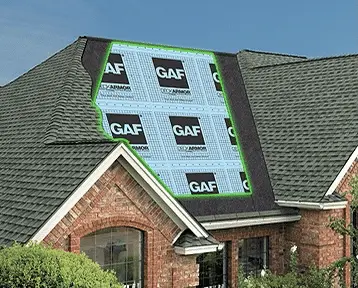
Your roof deck is a durable layer beneath the shingles that shields your home from moisture. Traditional underlayment materials, like tar paper, fail to provide the breathability and durability needed to combat ice dam damage. Modern options, such as GAF Deck-Armor™, offer superior protection:
- Allows trapped moisture to escape while blocking external water.
- Reinforces your roof’s durability during heavy snow and ice.
- Reduces the risk of mold and rot caused by lingering moisture.
High-Performance Shingles Built for Harsh Winters
Shingles help keep your roof watertight. Choosing shingles designed for New England’s unpredictable weather is key to preventing damage caused by ice dams.
- GAF Timberline® HDZ Shingles provide advanced protection with their Dura Grip™ adhesive, locking shingles tightly in place to resist ice and wind. Don’t forget that Coastal Windows & Exteriors offers an Unlimited Wind Speed Warranty! Your shingles are guaranteed to stay in place no matter the severity of wind storms.
- They feature an algae-resistant formula, maintaining curb appeal while protecting your home from harsh conditions.
- Select shingles with extended warranties for long-term peace of mind.
Ridge and Soffit Vents for Balanced Ventilation
Without proper ventilation, warm air trapped in the attic melts snow on your roof, which then refreezes at the edges. Balanced airflow is crucial to maintaining an even roof temperature, reducing the risk of ice dams on roofs.
- Use GAF Cobra® Ridge Vents to expel warm air from your attic.
- Pair them with GAF IntakePro™ Soffit Vents to bring in cold air, creating the perfect balance for a healthy attic environment.
Leak Barriers: Your Roof’s Secret Weapon
Leak barriers act as an additional shield against water infiltration caused by ice dams. These barriers are especially important in high-risk areas where water often pools or seeps.
- GAF StormGuard® Leak Barrier is a premium option that prevents leaks in valleys, around chimneys, and at roof edges.
- Its self-sealing technology offers maximum protection against ice and water damage.
New GAF Roof Installation Prevents Leaks
Protecting your home from ice dams requires more than one solution. Combining these essential roofing features creates a robust system capable of withstanding New England’s challenging winter conditions. Investing in products like Tiger Paw Roof Deck Protection and Timberline® HDZ Shingles helps fortify your roof from leaks, saving you from costly repairs caused by roof leaks and structural damage.
Does Ice Dams Mean I Need a New Roof?
Ice dams can cause significant damage to your roof, but they don’t always mean you need a full roof replacement. The severity of the damage depends on how long the issue has been left untreated and whether water has seeped into critical areas like your attic, walls, or ceiling.
Here’s how to evaluate whether ice dams on roofs signal the need for a new roof:
Signs of Extensive Damage:
- Lifting shingles or missing shingles where water has penetrated.
- Sagging areas in the roof structure caused by prolonged exposure to moisture.
- Mold or rot on roof decking or wooden rafters in your attic.
- Visible water stains or leaks inside your home.
When Repairs Are Sufficient:
- If the damage is isolated to a small area, repairing or replacing damaged shingles and underlayment may be enough.
- Properly sealing leaks and adding Ice & Water Shield in problem areas can prevent future damage.
When Replacement Is Necessary:
- If your roof is already near the end of its lifespan, the combined effects of ice dams and aging materials might make replacement a better option.
- Extensive rot or mold in the roof deck requires a full replacement to restore structural integrity.
Consult a professional roofer to assess the condition of your roof. They’ll inspect for roof leaks, water damage, and compromised structural elements to determine whether repair or replacement is the best solution.
Do Roof Vents Prevent Ice Dams?

Yes! Roof vents can help prevent ice dams on roofs by maintaining balanced attic temperatures. That’s because proper ventilation allows cold air to flow in and warm air to escape, reducing the chances of snow melting and refreezing on your roof.
Key types of roof vents include:
- Ridge Vents: These vents, like GAF Cobra® Ridge Vents, are installed at the roof’s peak to release warm air from the attic. They create a natural airflow system that helps regulate attic temperatures.
- Soffit Vents: These intake vents bring cold air into the attic, pushing warm air out through ridge vents. Products like GAF IntakePro™ Soffit Vents are designed to improve airflow efficiently.
Without proper ventilation, warm air trapped in the attic melts the snow on the roof, which refreezes at the edges. Ventilation prevents this cycle by keeping the roof surface consistent with outdoor temperatures. However, ventilation alone isn’t enough—it works best when paired with proper insulation and air sealing to prevent heat from entering the attic in the first place.
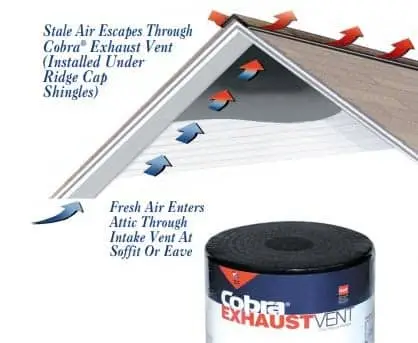
Action Steps for Extra Ventilation
Ventilation requires more than simply installing vents. Specific steps can make a significant difference in maintaining a balanced attic temperature and reducing heat escape. Follow these suggestions and maximize the effectiveness of your ventilation system:
- Seal air leakage areas around recessed lighting cans, electrical cables, and vent pipes. These gaps allow warm air to escape into your attic, warming the roof and creating ideal conditions for ice dams. Use caulk or foam to seal these areas effectively.
- Foam around your heat-protected lights, making sure they are fire-rated with zero-clearance to prevent warm air from pouring through these fixtures.
- Check attic hatches for proper sealing. If your attic hatch isn’t insulated or sealed tightly, warm air can easily leak into the attic. Adding weatherstripping or insulation around the hatch can prevent heat transfer.
- Clear soffit vents of insulation or debris. Blocked vents reduce airflow and make your ventilation system ineffective. Inspect these areas periodically to ensure air can flow freely.
Pair these steps with high-quality products like GAF Cobra® Ridge Vents and GAF IntakePro™ Soffit Vents for optimal airflow and protection against ice dams.
Can You Put Salt on Your Roof?
Can you put salt on your roof? Yes.
Should you put salt on your roof? Probably not.
Salt is sometimes used to melt ice on driveways and walkways, but it’s not recommended for use on your roof. While it may seem like a quick fix for ice dams, salt can cause more harm than good by damaging roofing materials and creating long-term issues.
Here’s why using salt on your roof is a bad idea:
- Shingle Damage: Salt is corrosive and can wear away the granules on asphalt shingles, reducing their lifespan and protective qualities.
- Water Runoff Issues: Meltwater mixed with salt can damage your gutters and downspouts, leading to clogs or corrosion.
- Environmental Impact: Salt runoff can harm plants, soil, and surrounding areas of your property.
Safer alternatives include:
- Roof Rakes: Use a roof rake to safely remove snow from the edges of your roof, minimizing the weight and insulation that lead to ice dams.
- Professional Services: Contact experts to remove ice dams safely without damaging your roof.
Instead of relying on salt, focus on prevention methods like insulation, ventilation, and leak barriers to tackle ice dams on roofs effectively.
Does Homeowners Insurance Cover Ice Dams?
The answer to whether homeowners insurance covers ice dams depends on the specifics of your policy. While many policies provide coverage for sudden and accidental damage caused by ice dams, there are limitations and exclusions to consider. Understanding your coverage can help you avoid surprises when dealing with roof leaks or interior damage caused by ice dams.
What’s Typically Covered?
Most standard homeowners insurance policies cover damage resulting from ice dams, including:
- Roof Damage: If ice dams cause your shingles to lift or lead to roof leaks, the cost to repair these issues is often covered.
- Interior Water Damage: Policies generally include coverage for water damage to ceilings, walls, and insulation caused by ice dam-related leaks.
- Personal Belongings: If water from an ice dam damages furniture, electronics, or other personal property, these losses may be included in your policy’s personal property protection.
What’s Typically Not Covered?
While some damage caused by ice dams on roofs may be covered, insurers often exclude certain scenarios:
- Preventable Damage: If the damage is determined to result from poor maintenance, such as blocked gutters or insufficient insulation, it may not be covered.
- Gradual Damage: Policies often exclude damage that occurs over time, like mold or rot caused by unresolved leaks.
- Ice Dam Removal: While insurance may pay for the damage caused by ice dams, the cost to remove the ice itself is typically excluded.
Steps to Protect Yourself
Taking preventive measures can reduce the risk of ice dams and minimize out-of-pocket expenses:
- Maintain proper insulation and ventilation in your attic to prevent ice dam formation.
- Clean gutters regularly to ensure water flows freely.
- Schedule routine roof inspections to catch potential vulnerabilities before winter hits.
What to Do if You Have Ice Dam Damage
If an ice dam causes damage to your home, start by doing the following:
- Document the damage with photos and detailed notes.
- Contact your insurance company to report the claim and understand your coverage.
- Hire a professional to assess the roof and provide an estimate for repairs.
While homeowners insurance often helps with the aftermath of ice dam damage, prevention remains the best approach. Replacing your roof and addressing vulnerabilities will save you time, money, and stress during New England winters.
Protect Your Home with a Durable Roofing System Built for New England Winters
When it comes to protecting your home from the relentless freeze-thaw cycles of New England winters, replacing your shingles isn’t enough. You need a comprehensive roofing system that safeguards against ice dams, roof leaks, and water damage. That’s where the GAF 6-Layer Roofing System comes in—a complete solution designed for superior performance and durability.
Why Install a GAF Roofing System?
- Leak Barrier: Protects vulnerable areas like valleys and eaves from water infiltration caused by ice dams.
- Roof Deck Protection: Prevents moisture from seeping into the roof while allowing trapped air to escape.
- Starter Strip Shingles: Provides a secure base for shingles, reducing the risk of shingle blow-offs.
- Lifetime Shingles: Offers unmatched durability, with advanced adhesive technology to withstand heavy winds and snow.
- Ridge Cap Shingles: Shields roof peaks while enhancing ventilation and aesthetic appeal.
- Attic Ventilation: Maintains balanced airflow to regulate attic temperatures, preventing ice dams on roofs and boosting energy efficiency.
Why Coastal Windows & Exteriors is the Right Choice for New England Roofing
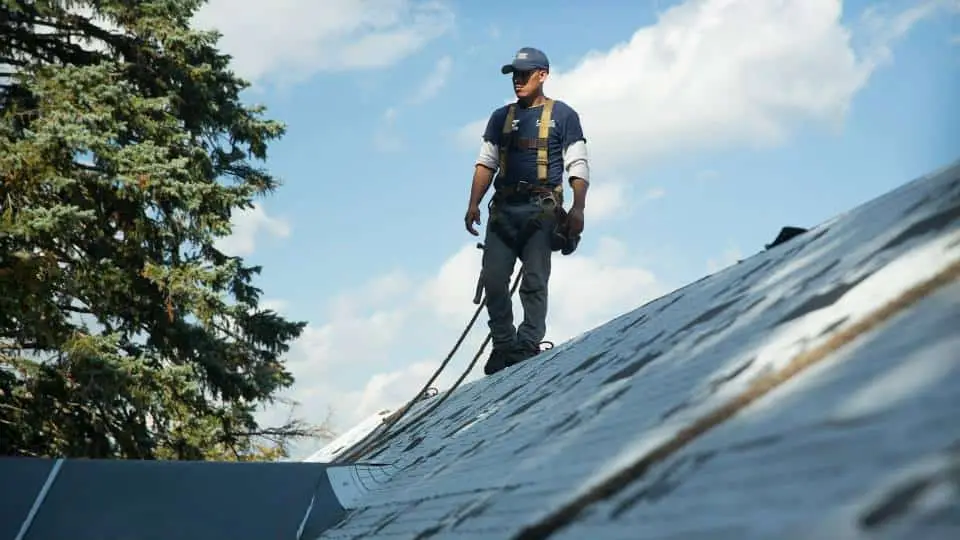
Coastal Windows & Exteriors is the #1 woman-owned roofing company in New England, as recognized by INC 5000 and North Shore Magazine’s Best of North Shore (BONS) Winner for 2023 and 2024. Led by the 2024 SBA Massachusetts Business Person of the Year, we take pride in offering exceptional craftsmanship and premium products, including:
- GAF Master Elite Roofer Certification—only 2% of roofers nationwide achieve this distinction.
- GAF Green Certified Roofer, showcasing our commitment to sustainability.
- Licensed and insured professionals for worry-free service.
- Exclusive warranties like the GAF Unlimited Wind Speed Warranty and GAF Golden Pledge Warranty for peace of mind.
Whether you’re looking for a traditional roofing system, solar roofing, or the durability of metal roofing, we have solutions tailored to meet your home’s needs.
Contact Us for a Free Estimate Today!
Don’t let ice dams and winter storms compromise your home. Protect what matters most with the best in the business—Coastal Windows & Exteriors. Contact us now for a free roofing estimate and discover how our GAF 6-Layer Roofing System can keep your home safe and secure all winter long.
Your roof deserves the best—because your home deserves the best. Let’s get started!



